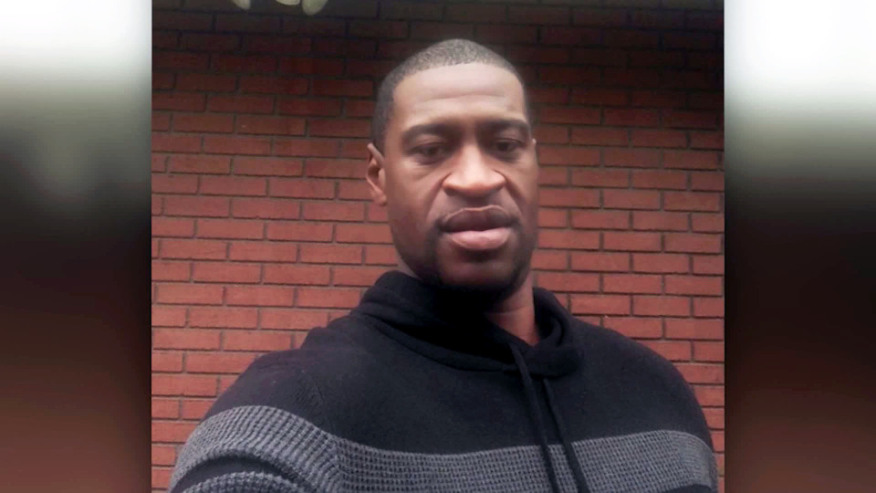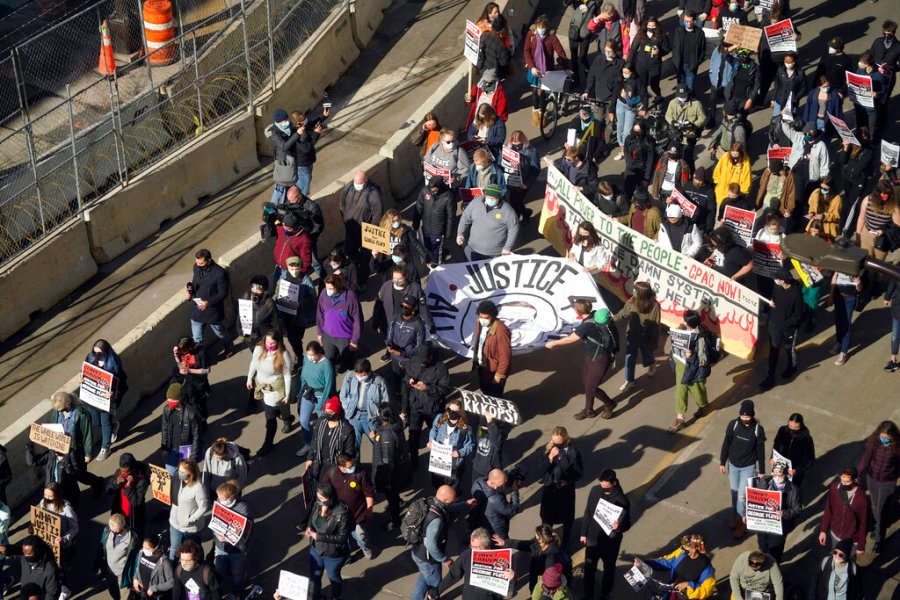Timeline: One year later, the aftermath of George Floyd’s death
Testing on staging11
MINNEAPOLIS (NewsNation Now) — The death of George Floyd sent shockwaves through a nation, setting off weeks of sometimes violent protests across the country and led to a national reckoning on racial justice.
The 46-year-old Black man was arrested by four police officers after being accused of using a counterfeit $20 bill at a Minneapolis corner grocery store. Floyd died after a white police officer, Derek Chauvin, pressed his knee of Floyd’s neck for more than 9 minutes while he was handcuffed and pleading that he couldn’t breathe.
A jury convicted Chauvin on all charges related to Floyd’s death including second-degree unintentional murder, third-degree murder and second-degree manslaughter.
Floyd’s death, captured on widely seen video, sparked protests and civil unrest in Minneapolis and across the world.
Here is a breakdown of key events since Floyd’s death:
May 25, 2020: george floyd is killed
Minneapolis police officers responded to a call after 8 p.m. about a potential counterfeit bill being used at Cups Foods. The four responding officers are Derek Chauvin, Thomas Lane, J. Kueng and Tou Thao.
They encounter Floyd, who struggles and ends up handcuffed on the ground. Chauvin used his knee to pin Floyd’s neck for nine minutes and 29 seconds while bystanders shout at him to stop. Bystander video shows Floyd crying “I can’t breathe” multiple times before going limp. He’s pronounced dead at a local hospital.
May 26, 2020: police release statement and bystander video posted online
Police issued a statement saying Floyd died after a “medical incident,” and that he physically resisted and appeared to be in medical distress. Minutes later, bystander video was posted online. Police released another statement saying the FBI will help investigate. All four officers involved in the incident were fired.
May 27-31 2020: PROTESTS AND UNREST
Mayor Jacob Frey calls for criminal charges against Chauvin. Protests lead to unrest in Minneapolis, with some people looting and starting fires. Gov. Tim Walz activates the Minnesota National Guard. Police abandon the 3rd Precinct station as protesters overtake it and set it on fire.
President Donald Trump tweets about “thugs” in Minneapolis protests and warns: “When the looting starts, the shooting starts.” Protests turn violent again in Minneapolis and other cities.
Protests spread to cities around the world, and continue throughout the week.
MAY 29, 2020: CHAUVIN IS ARRESTED
Chauvin is arrested and charged with third-degree murder and manslaughter.
June 1, 2020: MEDICAL EXAMINER RELEASES FLOYD DEATH FINDINGS
The county medical examiner finds that Floyd’s heart stopped as police restrained him and compressed his neck, noting Floyd had underlying health issues and listing fentanyl and methamphetamine use as “other significant conditions.”
JUNE 3, 2020: other officers charged
Ellison files a tougher second-degree murder charge against Chauvin and charges the other three officers who were involved in Floyd’s arrest.
June 8, 2020: FLOYD’S SERVICES HELD
Thousands pay their respects to Floyd in Houston, where he grew up. He was buried the next day.

July 15, 2020 – FLOYD’S FAMILY FILES LAWSUIT
Floyd’s family filed the federal civil rights lawsuit against the city, Chauvin and three other fired officers charged in his death. It alleged the officers violated Floyd’s rights when they restrained him, and that the city allowed a culture of excessive force, racism and impunity to flourish in its police force.
JAN. 12, 2021 : JUDGE RULES CHAUVIN WILL BE TRIED ALONE
Hennepin County Judge Peter Cahill ruled that Chauvin will be tried alone due to the courtroom capacity issues amid the coronavirus pandemic.
MARCH 9, 2021: JURY SELECTION BEGINS
The first potential jurors are questioned for Chauvin’s trial after a day’s delay for pretrial motions.
MARCH 12, 2021: FLOYD’S FAMILY REACHES $27M SETTLEMENT WITH MINNEAPOLIS
The city of Minneapolis agreed to pay $27 million to settle a civil lawsuit from Floyd’s family over his death in police custody.
Floyd family attorney Ben Crump called it the largest pretrial settlement ever for a civil rights claim, and thanked city leaders for “showing you care about George Floyd.”
march 19, 2021 – judge declines to delay trial
Judge Cahill denied a request to delay or move the trial out of the county. The motion, filed by Derek Chauvin’s attorney, said the trial should be moved due to concerns that a $27 million settlement for Floyd’s family had tainted the jury pool.
Judge Cahill called the timing “unfortunate” but declined to delay proceedings or move the trial. He said neither option would make it easier to seat an impartial jury.
MARCH 23, 2021: JURY SELECTION COMPLETED
In all, the jury, including three alternates, was made up of six white women, three white men, three Black men, one Black woman and two multiracial women, according to court records. All are U.S. citizens and residents of Hennepin County.
The jurors were sent detailed 16-page questionnaires to determine how much they have heard about the case and whether they’ve formed any opinions. Besides biographical and demographic information, jurors were asked about prior contacts with police, whether they have protested against police brutality and whether they believe the justice system is fair.
MARCH 29 TO APRIL 19 2021: THE TRIAL of derek chauvin
The prosecution called two weeks’ worth of witnesses to the stand whereas the defense only used two days of testimony before resting its case.
Law enforcement veterans inside and outside the Minneapolis department testified for the prosecution that Chauvin used excessive force and went against his training, while medical experts said Floyd died of asphyxia, or lack of oxygen, because his breathing was constricted by the way he was held down.

Notably, Minneapolis Police Chief Medaria Arradondo testified that Chauvin, 45, broke the department’s rules and ethics code.
Prosecutors used a legal doctrine called “spark of life” to call Floyd’s brother to testify about his life, and also used it to call Courtney Ross, Floyd’s girlfriend to the stand. Ross testified about her romance with Floyd and how an addiction to painkillers took hold of their life together. Minnesota is a rarity in explicitly permitting such “spark of life” testimony ahead of a verdict. Defense attorneys often complain that such testimony allows prosecutors to play on jurors’ emotions.
Floyd’s brother broke down on the witness stand as he was shown a picture of his late mother and a young George during the trial.
The teenager who filmed the cellphone video of the arrest that went viral cried in court as she testified saying she began recording because “it wasn’t right, he was suffering, he was in pain.”
The defense said Floyd put himself at risk by swallowing fentanyl and methamphetamine, then resisted officers trying to arrest him — factors that compounded his vulnerability to a diseased heart and hoped to raise sufficient doubt enough that Chauvin should be acquitted
Chauvin’s defense called a police use-of-force expert and a forensic pathologist to help make the case that Chauvin acted reasonably against a struggling suspect and that Floyd died because of an underlying heart condition and illegal drug use. Floyd had high blood pressure and narrowed arteries, and fentanyl and methamphetamine were found in his system.
April 20 2021: JURY CONVICTS CHAUVIN OF ALL CHARGES
A jury convicted former Minneapolis police officer Derek Chauvin in the death of George Floyd.
Chauvin, 45, was found guilty on all charges: second-degree unintentional murder, third-degree murder and second-degree manslaughter. The second-degree murder count, the most serious charge, carries up to 40 years in prison. The jury reached its verdict after deliberating about 10 hours over two days.
Chauvin is expected to be sentenced June 25.